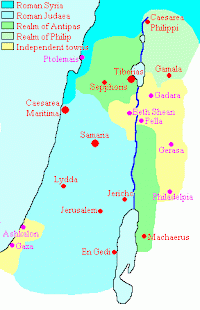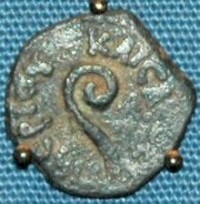Pontius Pilate (3)
Pontius Pilate: Roman prefect of Judaea from 26 CE to 36 CE, best known for the execution of Jesus of Nazareth.
Speculations about Pilate's early years

Judaea was so unimportant a province, that no senator would have deigned to become its governor. Consequently, its governors belonged to the second tier of the Roman elite, the order of the knights. These men were not entitled to the position of "legate" or "proconsul", but had to content themselves with the military title "prefect" (see below).
Like all members of the Pontius family, Pilate belonged to this equestrian order. We know that the Pontii originated from a region called Samnium in Central Italy, which had a reputation for its stubborn resistance to Roman expansionism. The Pontii could boast of a brilliant victory over the Romans (at the Caudine Forks in 321 VC), had led several armies against Rome in the first quarter of the first century BCE, and prided itself on its resistance to the coup d'état of Julius Caesar. But in the days of Pontius Pilate, this was just the folklore of a family that must by now have been thoroughly Roman. The family may have upheld its military traditions, especially since the emperor Augustus had done his best to stress the military character of the order of the knights. We may speculate that Pontius Pilate had started his career as a soldier: after all, "prefect" was a military title, and the Romans were right to demand at least some military experience before someone became governor of a province.
In the Roman Empire, advancement depended on patronage. There has been some scholarly speculation that Pilate was promoted by the powerful commander of the guard of the emperor Tiberius, a man named Seianus. It may be true and is perhaps even plausible, but we simply cannot know.
Before Pilate assumed the governorship of his province in 26 CE, he must have sought advice. We may know one of his advisors: the high priest Joseph Caiaphas. Pilate's predecessor Valerius Gratus (tenure of office: 15-26 CE) had been looking for a high priest he could rely on, and had dismissed three high priests before appointing Caiaphas in 18.note Pilate never changed the high priest, which can only mean that he had found in Caiaphas a man who could be trusted.
Pilate must have studied the Jewish religion before he went to Judaea. He must have read about the policy of the Seleucid king Antiochus IV Epiphanes, who had tried to civilize the Jews and had persecuted those who had continued their atrocious practice of mutilating the genitals of boys. It has been argued that Pilate tried to follow in Antiochus' footsteps, and that the incidents we will discuss below were deliberate provocations. This point of view is untenable, since it ignores the negative bias of the Jewish sources we mentioned above.

Besides, there may be positive proof that Pilate embarked upon a policy of cooperation. Since there was no Syrian governor to mint coins, Pilate had to do it himself. These coins show the staff of an Italian seer (a lituus); on the reverse, one could see a bunch of grapes, which is the usual picture on any Jewish coin. Pilate thus combined an inoffensive pagan and an inoffensive Jewish symbol, which may reflect a policy of equal rights to Jews and pagans. He would not force the Jews to lay down their ancestral ways; he invited them to be Rome's equals.